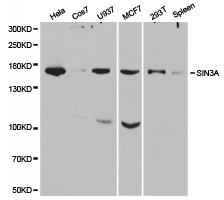mSin3A (SIN3A) Rabbit Polyclonal Antibody
Frequently bought together (1)
Other products for "SIN3A"
Specifications
| Product Data | |
| Applications | ChIP, ICC/IF, IP, WB |
| Recommended Dilution | WB 1:500 - 1:2000;IF 1:50 - 1:200;IP 1:50 - 1:200;ChIP 1:20 - 1:100 |
| Reactivities | Human, Mouse, Rat |
| Host | Rabbit |
| Isotype | IgG |
| Clonality | Polyclonal |
| Immunogen | Recombinant protein of human SIN3A |
| Formulation | Store at -20C or -80C. Avoid freeze / thaw cycles. Buffer: PBS with 0.02% sodium azide, 50% glycerol, pH7.3 |
| Concentration | lot specific |
| Purification | Affinity purification |
| Conjugation | Unconjugated |
| Storage | Store at -20°C as received. |
| Stability | Stable for 12 months from date of receipt. |
| Gene Name | SIN3 transcription regulator family member A |
| Database Link | |
| Background | SIN3 was originally identified as a negative regulator of transcription in budding yeast. Since then, three isoforms of the SIN3 proteins have been identified in mammalian cells, as products of two different genes, SIN3A and SIN3B. Both SIN3A and SIN3B are nuclear proteins that function as scaffolding subunits for the multi-subunit SIN3 transcriptional repressor complex, containing SIN3A or SIN3B, HDAC1, HDAC2, SDS3, RBBP4/RBAP48, RBBP7/RBAP46, SAP30, and SAP18. SIN3 proteins contain four paired amphipathic alpha-helix (PAH) motifs that function in the recruitment of the SIN3 complex to target genes by binding a multitude of DNA-binding transcriptional repressor proteins, including Mad1, p53, E2F4, HCF-1, AML1, Elk-1, NRSF, CTCF, ERa, and MeCP2. In addition, SIN3 proteins contain an HDAC interaction domain (HID), which mediates binding of HDAC1 and HDAC2 via the SDS3 bridging protein, and a highly conserved region (HCR) at the carboxy terminus, which contributes to repressor protein binding. RBBP4 and RBBP7 proteins also bind to SDS3 and contribute to nucleosome binding of the complex. The SIN3 complex functions to repress transcription, in part, by deacetylating histones at target gene promoters. In addition, recent studies have shown that SIN3 is recruited to the coding regions of repressed and active genes, where it deacetylates histones and suppresses spurious transcription by RNA polymerase II. In addition to histone deacetylase activity, the SIN3 complex associates with histone methyltransferase (ESET), histone demethylase (JARID1A/RBP2), ATP-dependent chromatin remodeling (SWI/SNF), methylcytosine dioxygenase (TET1), and O-GlcNAc transferase (OGT) activities, all of which appear to contribute to the regulation of target genes. The SIN3 complex is critical for proper regulation of embryonic development, cell growth and proliferation, apoptosis, DNA replication, DNA repair, and DNA methylation (imprinting and X-chromosome inactivation) |
| Synonyms | WITKOS |
| Reference Data | |
| Protein Families | Druggable Genome, Transcription Factors |
| Protein Pathways | Huntington's disease |
Documents
| Product Manuals |
| FAQs |
| SDS |
{0} Product Review(s)
0 Product Review(s)
Submit review
Be the first one to submit a review
Product Citations
*Delivery time may vary from web posted schedule. Occasional delays may occur due to unforeseen
complexities in the preparation of your product. International customers may expect an additional 1-2 weeks
in shipping.






























































































































































































































































 Germany
Germany
 Japan
Japan
 United Kingdom
United Kingdom
 China
China




